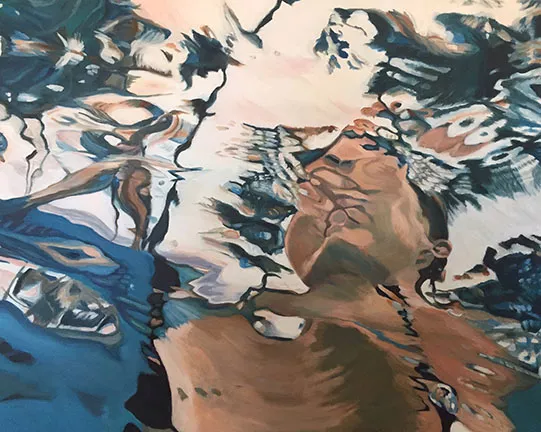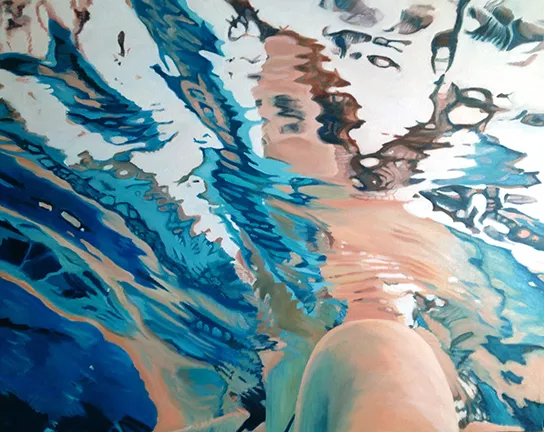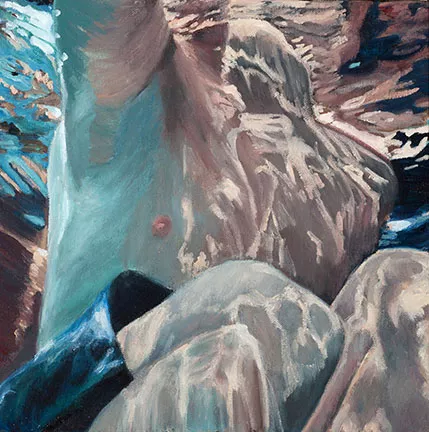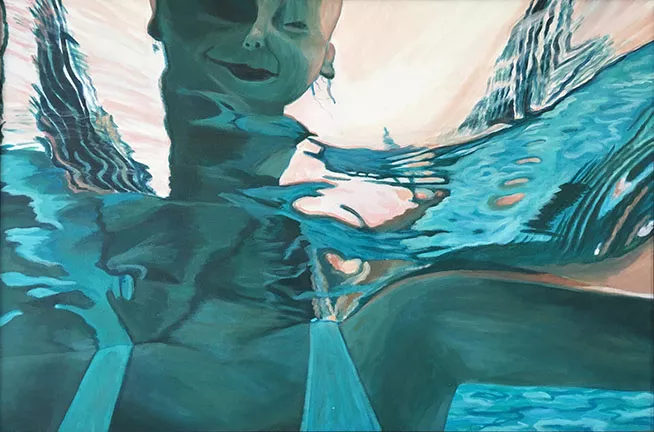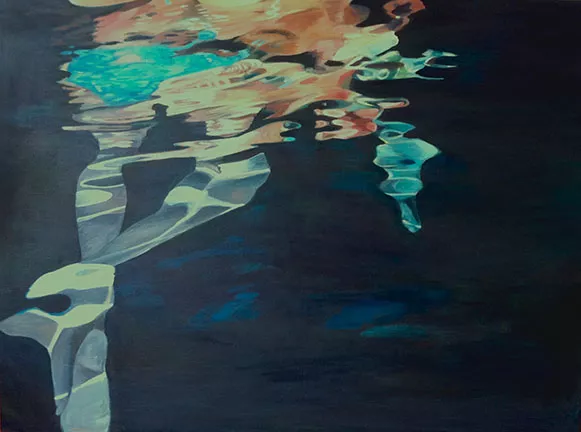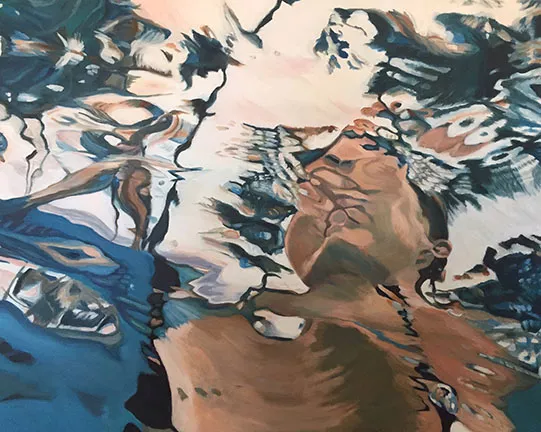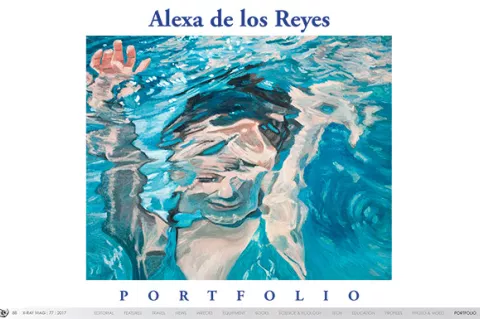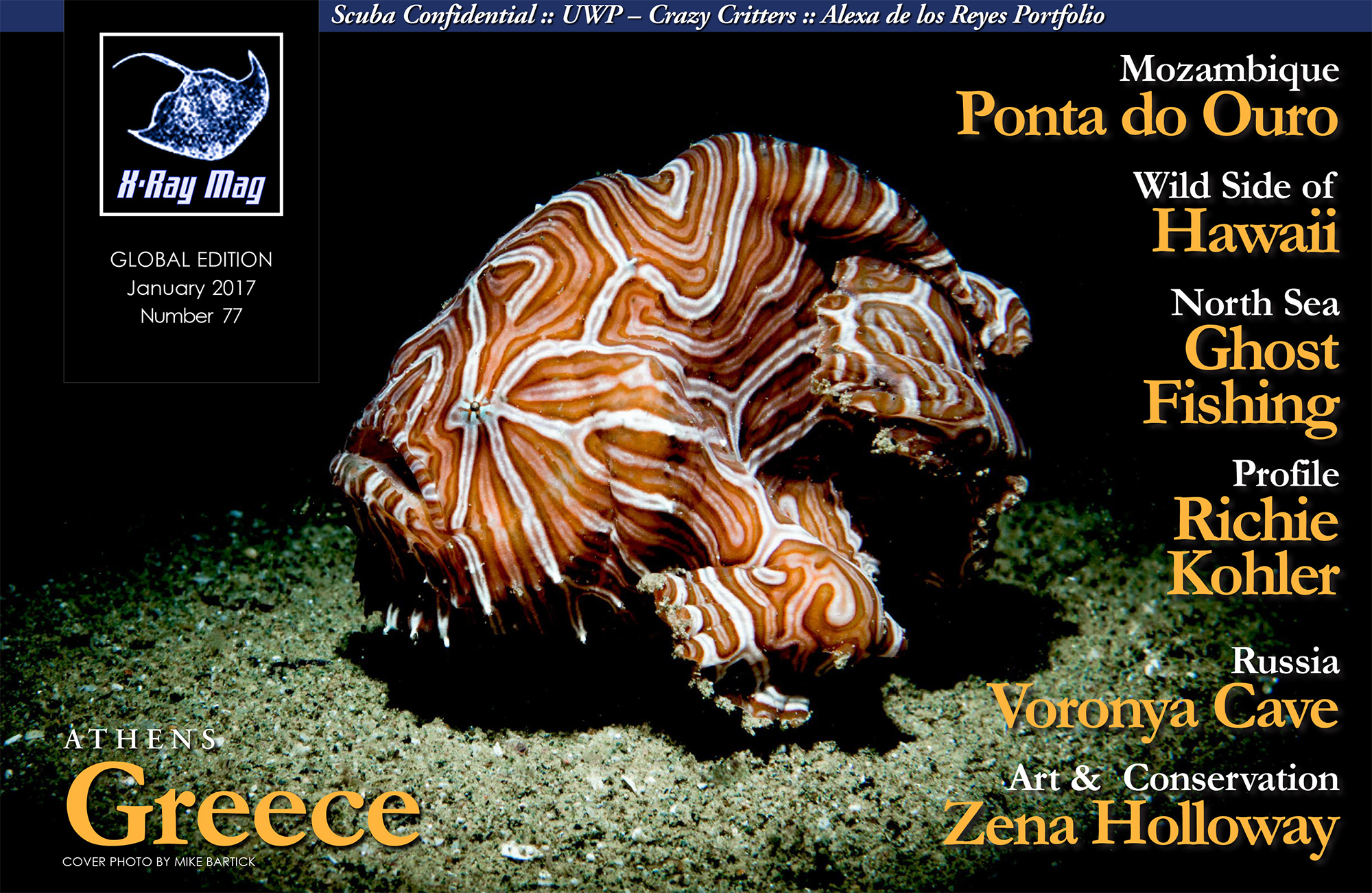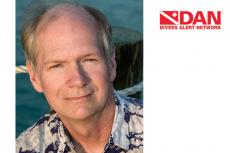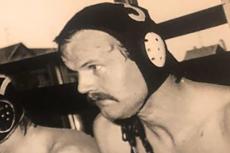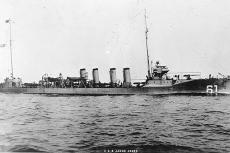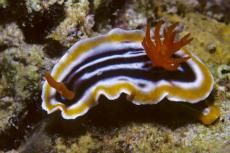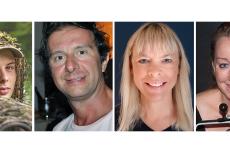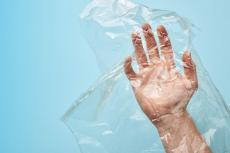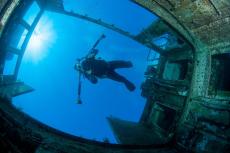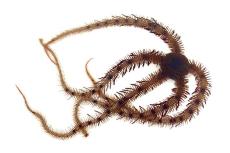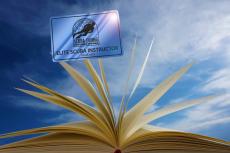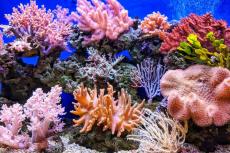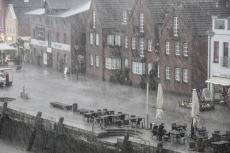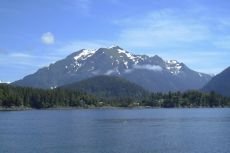
In mind-bending, eye-popping portraits, American artist Alexa de los Reyes has created a series of oils on canvas, which capture the abstract effects of refraction and reflection of water on the human form. <i>X-Ray Mag</i> caught up with the artist to find out more about her artistic process, inspiration and perspectives—discovering a deeper meaning and symbolism underlying her artworks.
Contributed by
X-RAY MAG: Tell us about yourself, your background and how you became an artist.
ADLR: For as long as I can remember, I have drawn and painted. I started painting seriously a few years after graduating from college, where I studied history and literature. I always thought I would be a writer, and I am employed largely as an editor, but I discovered that I feel much freer expressing myself through paint rather than words. The impulse for painting comes from the same place, however—the desire to examine, interpret and share my perception of the world. My approach to painting is influenced by literary concepts and constructs—metaphors, analogies and symbolism—but my medium is visual.
I got my bachelor’s degree in History and Literature at Harvard in 1996. I put visual art aside while in college, then I took it up again when I moved to South America after graduation. I have taken art classes throughout my life in various cities and institutions, including Massachusetts College of Art, School of Visual Art in New York City, La Liga de Arte in Puerto Rico and Washington Studio School in Washington, DC.
I am originally from Boston, Massachusetts, of Ashkenazi Jewish descent. My husband is of Cuban-Puerto Rican descent, and we live in Washington, DC, where he is a professor of business ethics, with our two boys (ages ten and seven). I have lived in many places: Spain, Chile, Argentina, Puerto Rico—and in the United States in Brooklyn, New York; Philadelphia, Pennsylvania; and now Washington, DC.
As a creative child, I was naturally drawn to painting. Both my maternal grandmother and great-grandmother painted with watercolor. I’ve played around with different media, but I like to work with blended layers, which watercolors and acrylics do not permit. While living in Puerto Rico, I used acrylics, because in that humid environment, the oil paint would never dry (my first underwater paintings were in acrylic).
When I became pregnant with my first child in 2005, I started using water-soluble oil paints to avoid harsh fumes, and I continue to use them. For many of my paintings, I use photographic source materials, because I find so many gorgeous and compelling subjects in the real world that I want to share.
In painting the images, I choose which aspects to enhance, highlight or omit, in order to present the essence of what I find most captivating. I almost always imagine my paintings to be massive, bigger than life-size. But for now, the physical constraints of my studio and budget don’t allow it.
X-RAY MAG: Why abstract underwater themes? How did you come to this theme and how did you develop your style of painting?
ADLR: While living in Puerto Rico with my husband in 2003, I was invited to participate in a group art show. At the time I was mainly painting commissioned portraits, but for the show I wanted to do a series of paintings reflective of my experience living there.
I used to take evening walks along the harbor in Old San Juan, and one evening, it just struck me that I should paint people underwater. When creative ideas pop into my head out of the blue, I take them seriously. I bought a disposable underwater camera, like the kind tourists use on vacation, and asked some friends to do a photo session in a swimming pool, just to see what would happen.
The process was much harder to control than I anticipated—everyone was floating around, it was hard to see. With the point-and-shoot camera it is impossible to know what is going to turn out, etc. But when I developed the pictures, I was surprised by how much I loved what had been captured on film. It was not what I expected, it was better.
Later, when I began working on the paintings I realized how the imagery seemed like a perfect metaphor for the feeling of living in that foreign culture—disorienting, eerie, blissful, unfamiliar, distorting, transporting. Thirteen years later, I continue to be inspired by the mystery and beauty of these images.
X-RAY MAG: What is the backstory of the title of your underwater series, “Out of Our Element”?
ADLR: When I took the first series of underwater photos, I was fighting against the water—wanting to stay still, wanting my subjects to stay still, trying to see through bubbles. Instead of artfully composed portraits, as I was attempting, I got these crazy-looking refractions and reflections, which I quickly realized were a much more apt depiction of being in the water. I learned to relinquish control and allow the water dictate the photograph.
Several of these works are self-portraits (Kaleidoslexa, Continental Drift, Turbulessence—the camera is underwater and my head is above the surface), and I am almost unrecognizable to myself. But that is what I look like through the lens of water. I know I “look” different to people in foreign cultures because they have a different cultural lens. I came up with the title because it refers to both the experience of being in water, a foreign element, and also the experience of living in Puerto Rico, as I described above.
X-RAY MAG: You mention “refractions and reflections” in the water... what do they mean to you?
ADLR: In many of my underwater photos, I see distinct images in the reflections— birds, fish, faces. I do not make them up, they just show up. My father is a psychiatrist (my grandfather was a Freudian psychoanalyst from Vienna), and I grew up being aware of the symbolism of our dreams; when I see these images, to me they are open to interpretation like dreams.
One of my early paintings, Quickening, was a self-portrait I painted when I was about four months pregnant with my first child. In the photograph, I see what looks like the face of a fetus hovering in a funnel above me, as well as some ominous-looking shark and monster shapes over my shoulder. To me, it perfectly captured my psychological state at the time. The water creates a dream-like environment—the usual laws of physics do not seem to apply, so perhaps we are more open to messages from our subconscious.
X-RAY MAG: What are the steps in your artistic method or creative process?
ADLR: Over the years, I have taken many pictures of family and friends in different bodies of water—swimming pools, lakes, oceans. While I know which light conditions tend to create the images I find most interesting, for every roll of film I take (I still have not made the leap to digital), there might be only one or two images that surprise and captivate me.
Once I have chosen the image to paint, I try to replicate it exactly—for me, what is real is what is fascinating. I enjoy the process of looking closely and trying to puzzle out the reflections and refractions while also imagining that they are symbols that have been conjured up by someone’s subconscious.
X-RAY MAG: What camera and lighting gear do you use underwater?
ADLR: I do not use any gear aside from the disposable underwater cameras you can get in a drug store. For different lighting environments, I depend on the weather, time of day and body of water. I have considered getting better equipment, but as I am not trying to influence the environment but rather just capture what is there, the ease and spontaneity works for me. Through trial and error over the years, I have learned about the angles and lighting environments that tend to produce images I like, but I am often intrigued by unanticipated results.
X-RAY MAG: What was unexpected in the underwater images you captured, or the underwater experience, personally?
ADLR: The images I use for the underwater paintings are taken straight from the real world, something we have all seen before. But without a camera, it is hard to see them. I could never predict the particular colors and forms that show up. But even if they are not what I could have imagined, they make perfect sense once I see them, because they are real. This “unexpected but true” aspect provides a jolt of energy. It is a challenge to our perceptions, which can be thrilling. For me, a work of art fails if it is predictable.
X-RAY MAG: What is your relationship to the underwater world and coral reefs? In your relationship with reefs and the sea, where have you had your favorite experiences?
ADLR: I have always had a love/terror relationship with water. I vividly remember my first real snorkeling experience in the Caribbean as a child when I encountered two barracuda and a stingray (near Virgin Gorda). It was exhilarating and enchanting, though I spent much of the time scanning the distance for approaching sharks and hatching escape plans. I love swimming, and at the same time, I find being underwater to be very haunting. I think my paintings are informed by this combination of delight, awe and fear.
I have gone snorkeling off Virgin Gorda and Tortola and in many places around Puerto Rico. I do not think it is permitted anymore, but years ago, we swam at night in the bioluminescent bay in Vieques. Jumping into the bay in pitch darkness was almost too hard for me, but it was magical swimming through the glowing water.
X-RAY MAG: On residing in another country, you have described the feeling of living in a foreign culture as “disorienting, eerie, blissful, unfamiliar, distorting, transporting”. Would you tell us more about this idea and how it influences your artwork?
ADLR: Like being underwater, living in a foreign culture stimulates our senses in new ways—different sights, smells, sounds. It creates a heightened awareness, like all traveling does, but day-to-day life in a foreign culture requires more sustained effort. It can be an emotional roller-coaster. I have lived in several Spanish-speaking countries, and though I speak Spanish fluently, there is still a cultural language barrier—I always had a feeling of not quite understanding other people and not quite being understood.
In Puerto Rico, I was not a natural physical fit—my Eastern European genes do not adapt well to tropical heat and humidity, I was constantly covered with mosquito bites, and I was a vegan on a pork-crazy island, with scarce fresh produce. So, I was, in many ways, “out of my element.” No matter how gorgeous or enjoyable the surroundings, and how gregarious and appealing the people, adapting to (or struggling with) the ways of eating, conducting business, dressing, getting around, communicating, making jokes, all require stepping outside your comfort zone. You gain a much deeper perspective into yourself in the process. My experiences living abroad have been truly essential and fundamental for making me into a more compassionate global citizen, with a critical eye.
X-RAY MAG: You mention water and distortion. How does super-realism in your underwater paintings transcend into abstraction? Do you use special compositional techniques, lighting or angles?
ADLR: We all know how water distorts: when you stand or float in water and look down at your legs, they look tiny and bizarre. But until I got it on film, I would not have been able to describe how we look from under the water, looking up. Other than cropping images for impactful compositions, I do not do any manipulating—it is just what gets captured on the film.
In terms of special angles, I have learned that the interaction of bodies and light at the surface, and the contrast between what’s above and what is below, is what I usually find most compelling. So, that is where I tend to focus. But I do not manipulate the images.
X-RAY MAG: You have sold many of the paintings in your underwater series. How do people respond to your work?
ADLR: Well, I cannot say for certain why my paintings speak to different people, but I am glad that they do! One of my favorite quotes by Pablo Picasso is, “El arte sacude del alma el polvo de la vida cotidiana,” or “Art shakes the dust of daily life from the soul.” I like to think that people find this quality in my paintings.
X-RAY MAG: What are your thoughts on ocean and freshwater conservation and how does your artwork relate to these issues?
ADLR: My artwork does not relate explicitly to conservation, but all of my painting series, representational and abstract, stem from experiencing awe in nature. Nothing man-made can evoke the wonder that comes from being immersed in a forest, on top of a mountain, or under the water. I aim to communicate this reverence through my art.
X-RAY MAG: What is the message or experience you want viewers of your artwork to have or understand?
ADLR: The experience I try to share is one of mystery, intrigue and wonder. ■
Visit the artist’s website for more information or to order originals, limited edition archival giclée prints or commissions at: Lexrey.com or Etsy.com/shop/LexreyPaintings.
The experience I try to share is one of mystery, intrigue and wonder.
— Alexa de los Reyes
Published in
-
X-Ray Mag #77
- Læs mere om X-Ray Mag #77
- Log ind for at skrive kommentarer
